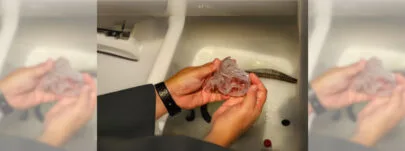
How to Clean ResMed CPAP: A Quick Daily Routine
CPAP is an effective treatment for obstructive sleep apnea. By delivering a continuous stream of pressurized air while you sleep, CPAP keeps your airways free from obstruction. This prevents the breathing pauses caused by obstructive sleep apnea that result in you frequently waking through the night for air.
CPAP helps improve your sleep by reducing the symptoms of sleep apnea. Without treatment, obstructive sleep apnea can increase the risk of health conditions like heart disease, stroke and diabetes.
However, it is important to keep your CPAP equipment clean to ensure the treatment remains effective and hygienic. The good news is that how to clean CPAP ResMed parts involves a quick daily routine where you only need to set aside five minutes each day.
What Cleaning Items Do You Need?
The daily cleaning of your CPAP ResMed equipment does not require any specialty cleaners. You can clean the parts with standard household items.
All you require are the following:
- a sink or tub in which to place the parts
- warm, drinking-quality water, ideally around 86 degrees Fahrenheit
- a mild liquid detergent
- a clean towel
That’s it! Using a mild detergent is important as it reduces the risk of damaging the mask cushion when you clean it. A mild soap will also help avoid irritating your skin when in contact with the mask. It also prevents irritating your lungs when inhaling the pressurized air.
Cleaning products to avoid include:
- antibacterial soaps
- bleach
- alcohol
- scented oils
- strongly scented products
You also want to avoid the temptation to chuck CPAP parts in your washing machine, as it is likely to damage them and require you to replace them ahead of schedule.
How to Clean CPAP ResMed Parts Daily
The mask cushion is the part that sits against your skin, forming a seal to prevent any leakage of air that would reduce the effectiveness of CPAP. The cushion needs cleaning every day to remove oil and dirt deposited from the skin, as this can soften the cushion and impact the all-important seal. Daily cleaning also promotes better hygiene.
The six stages of your five-minute daily clean are as follows.
- Unplug your CPAP device
- Separate the mask and tubing from the CPAP device
- Separate the mask into its three parts – headgear, frame and cushion
- Place the mask cushion into a sink or tub and rub gently with warm water and a mild detergent
- Rinse the mask cushion thoroughly using warm, drinking quality water
- Place the mask cushion on a clean towel to dry. Make sure the towel is sat on a flat surface and not in direct sunlight.
You can always clean the headgear and frame at the same time as this will not add much time to the process. However, as we will come onto, the frame and headgear can be cleaned weekly.
Don’t Forget the Humidifier Tub
Most modern CPAP devices come with a humidifier to warm and moisten the air. This makes CPAP more comfortable by eliminating dryness or irritation in the mouth or nasal passages.
The humidifier tub requires a daily clean too, and this task is simpler still. Once you have unplugged the CPAP machine and disconnected the humidifier tub, all you require is a clean disposable cloth to give the humidifier tub a good clean. Check to make sure it is clean and free of any discoloration.
Place the tub on the towel alongside the mask and let it dry during the day away from direct sunlight.
CPAP Parts That Need a Weekly Clean
The frame and headgear of the mask can be washed weekly. This can be done by washing them alongside the mask cushion on a set day every week.
The humidifier tub could also do with a good weekly soak. This can be done in a tub of warm water using a mild dishwashing liquid. Alternatively, you could use a solution of one part vinegar and nine parts room-temperature water.
The humidifier tub will need a thorough rinsing afterward using warm, drinking-quality water before drying on a towel on a flat surface. Once again, you want to avoid drying the tub in direct sunlight.
CPAP Tubing
The tubing that delivers the pressurized air from the CPAP machine to the mask is crucial for the effective and hygienic treatment of obstructive sleep apnea. Tubing should be cleaned on a weekly basis to prevent any build-up of mold and to remove bacteria and allergens.
As with the mask cushion and humidifier tub, the steps for cleaning the tubing are quick and straightforward.
- unplug the CPAP machine
- separate the tubing from the mask and CPAP machine
- rinse the tubing inside and out in a tub or sink using warm drinking quality water and mild dishwashing liquid
- rinse once more, but this time with warm drinking-quality water only
- place the tubing on a towel on a flat surface out of direct sunlight to dry
As with the mask cushion, you want to avoid using stronger detergents as they could damage the tubing or leave a residue that could be harmful to inhale.
Check the Replacement Schedule
Replacing the CPAP parts as recommended by the manufacturer is just as important as your daily and weekly cleaning routine. It is generally recommended that parts be replaced as follows:
- mask cushion monthly
- filters monthly
- mask frame every three months
- tubing every three months
- mask headgear every six months
- humidifier tub every six months
Final Thoughts
When you appreciate how to clean CPAP ResMed parts and how quick the task is, you realize that it only requires five minutes out of your day. These are five minutes well spent as they help ensure continued effective treatment of obstructive sleep apnea, reducing the debilitating symptoms of the disorder and improving the quality of your restorative sleep.
Source:
https://www.resmed.com/en-us/sleep-apnea/cpap-parts-support/cleaning-cpap-equipment/



